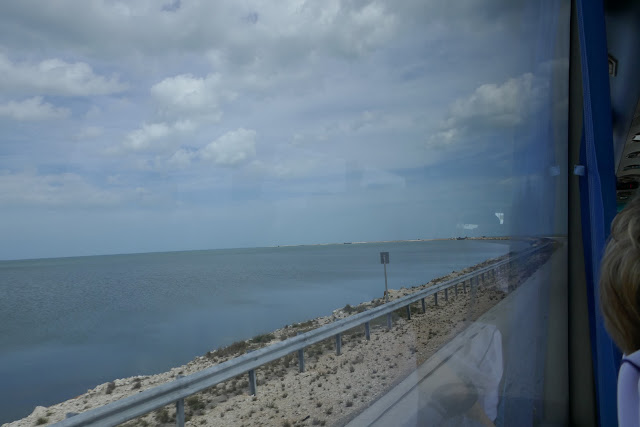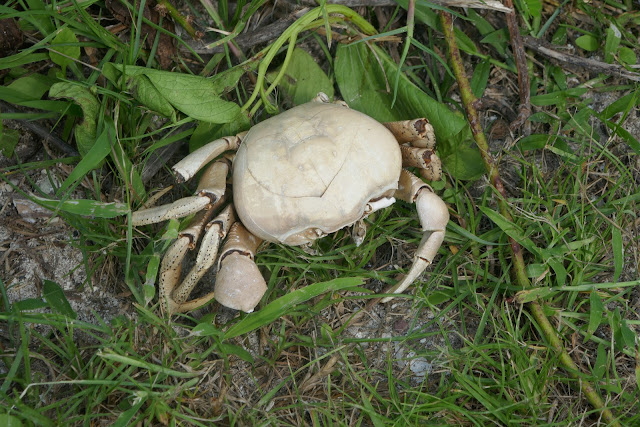With the hope that the fishing might be good too I brought along my fly rod and spinning rod with associated gear, and my snorkeling stuff. We flew into Santa Clara, which is an old Russian military airport, complete with abandoned MIGs in their bunkers, in the middle of Cuba, about 60 min from the north coast. After clearing customs and boarding our tour bus, these next several pictures were taken through the window of our bus on the way to Santa Maria, the island housing our resort where we were scheduled to stay.
The bus had a tour guide with lots of information. For example, the tree of Cuba is the royal palm. Who would have guessed? But they were everywhere and huge. The leaves of the tree are used locally for roofing.
We passed through several villages, all with very poor housing, so I took a few pictures of the better looking homes on one main street.
On the way we passed a number of tobacco fields that were very well maintained. You will remember that cigars are a major product of Cuba -- which are reputed to be the best in the world.
As we approached the coast, one of the last towns housed a famous ice cream (Helados) factory, which supplied all of the resorts in the area, and its products are very good. I had a different ice cream bowl every night in one of the several different restaurants on the island.
After about an hour of travel crossing the mainland, we arrived at the coast and entered the causeway to the island. This is the best I could do through the window. Note the causeway curves away to the left in the far distance.
Can you believe that this causeway is 48 kilometers long to Santa Maria Island? When the Russians abandoned Cuba, there was little left for creating an economic base, so in 1989, Castro decided that tourism would be a major source of income. The sand beaches on the north shores of Cuba and its adjacent islands were the best bet, but how to get to the islands? To achieve this goal, the Cubans dug out a huge chunk of one of the nearby mountains to serve as a base, and the causeway required a decade or more to finish about 20 years ago. It was designed to service all the hotels that were to be built subsequently on the island. No one else lives there, nor did they before it became a "tourist mecca". The hotel and restaurant staffs to the resorts are bused in and out every day and live on the mainland. Note: Other causeways were built to access other off-shore archipelago islands along the north shore of Cuba. As the causeway is entirely rock based, like a solid dam, there are tidal through-ways cut along it frequently, which allow the sea creatures and tidal water pressure to equalize on the two sides like the example below.
There are a few buildings out on the island that are not hotels like the marina below, which has available catamarans, but all appear to be out on the water somewhere. There is also a police and gas station and a health unit, but little else.
We arrived at our hotel and checked in.
The staff was very nice and quickly led us to our second story pad. Nancy is waiting at the top for her suitcases. Happily that did not involve me this time!! (although we did have to haul them down the stairs at 6 a.m. on the morning we departed).
From our porch, the pool view was nice. There was a larger one off screen to the left.
And then from the pool area, the view is back to our room, which was on the right corner at the second level in this picture.
On the inside, my favorite afternoon spot was in the outside shower. Each day was about 28C or 80F, thus wonderfully comfortable to be outside, naked and wet.
And my required 'comfortable' bed in its associated room. Also, you go straight through to the door in the center of the picture, which leads to the bathroom areas and the outside fenced in shower porch.
We quickly went to the sun. Actually Nancy goes to the sun, and I go to the shade - as the sun is no longer my best friend.
Of course, sitting in such a warm relaxing place playing with your ipad had the expected consequence ... somnolence, but nothing worse.
On the way to one of the beaches, we pass our breakfast-lunch building off screen on the right below.
We were directed to all of the hotels activities and resort structures by our hostess Dianelis, who was always available and helpful for things like locations for events and booking times for dinner in different restaurants, etc. Again the breakfast/lunch building on the right.
One of the events we enjoyed was a local eco-tour with our guide Navy.
I love seeing different environments and being able to discuss what we see with a guide. Mangroves are common in Florida and similar longitudes, but I had not before seen one of the mangrove seeds that are dropped, land point-down and settle into the sand to grow and increase the mangrove's footprint.
And thus the beginning of a new dense mangrove. The dense root system is the rookery of many minnow species and crustacean forms, which are critically important in the biology of the aquatic system, as well as a collector of sand to create new land. In Cuba it is illegal to cut them down.
Other interesting points along the tour included the experiment focused on different forms of concrete to discover which one was the best suited to be used in a salt water environment. This experiment was long over, but the subjects still stand ready to report again and again.
Many of the shells that volunteered below were quite lovely, and this one wanted to come home with us ... hush.
Other critters included a large land crab, the size of your fist. In this case, a dead one, as the live ones don't hang around very long when you show up.
And then there is the local botany. As I mentioned, the tree of Cuba is the Royal Palm. But heavily transplanted around the resort were coconut palms. These nuts were harvested frequently for food and to eliminate the possibility of human head injuries when they fall. I got bonked pretty good once years ago in the Cayman islands.
There were also beautiful flowing trees like the gorgeous Plumeria below. Note the many future flowers coming on the left side just behind this mature flower.
Many other flowering plants decorated the grounds, like bougainvillea.
And others ...
Indeed, I got to see many other plants on my daily walks down the concrete path (see below) extending from our resort a distance of 3 km down the road to the next resort (an unbroken beach connected them too, but the beach was steeply sloped and difficult to walk on ... to be shown further on).
So how about the beach and accesses to the water? There were two beaches in the resort; one facing the north east and one the west. As the wind always came from the north east onto the long beach, which extended for miles to the next resort, that area experienced very rough water. However, the approach to that beach was scenic below.
Once on the beach, looking to the east, you can see quite a distance, and it is all sand. Note the steep wall of sand at the high tide level, and soft on the top, thus difficult for an old man to walk on.
The beach bar is immediately to the right. No I did frequent it.
The sharp rise in the beach is due to the pounding surf. This is most obvious when looking immediately to the left or west where there is no beach sand but volcanic rock.
If we leave this beach and go through the resort to the west beach, this is the beach access at low tide (as measured against the two little lounging-huts on legs). Note it is much calmer and the hammocks are above the water at low tide
Then at high tide. The hammocks are in the water.
This 'high' tide is when the schools of minnows come into the shallow water (if you can see them in this picture as I can).
At the end of a 'hard' day of staying awake, there is nothing like a margarita at poolside watching the sun set.
On the last day, kindly Dianelis showed up at our room with a couple of special drinks for us before dinner.
Happily Nancy does not drink vodka but I do! Needless to say I had both of them....
We left for the airport then next morning at 6:30 am for the 90 min ride back to the airport. I won't describe my nightmare of standing in line for an hour, discovering (via the x-ray machines) a lighter in my back-back, leaving my exit visa in our room, having Nancy accidentally pick up my passport at Cuban customs (although we eventually found it and I boarded the plane for home), and finally shoveling out our car at the airport parking as a result of the blizzard when we left for Cuba. Welcome back to the great white north ...
And here we are today at home .. in another blizzard!! Apparently wearing my Cuba hat did not change things here for the better. Thus we will likely return to Cuba in the future, especially if I can find a place with kayaks and calmer seas.
The good news is that we will escape again in two weeks to see our daughter Jenifer and my sister Connie and both their spouses in Seattle, and then trip over to Hawaii with Jen and Scot for a week. Thank heavens!!! Adios and aloha amigos.











































jealous....
ReplyDeletewish you were there son
DeleteThanks so much for letting us share your Cuba trip. It was fun to see the pictures and hear about the area you were in. Sorry about the return snow. This is why we now live in VA!
ReplyDelete